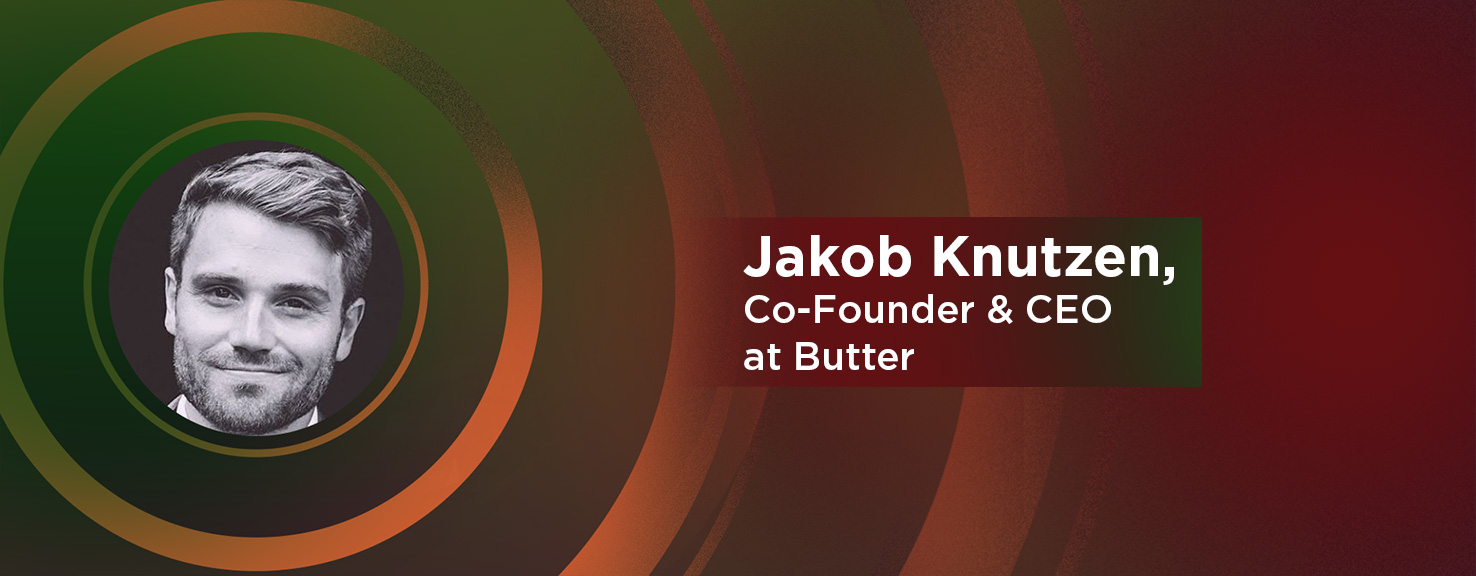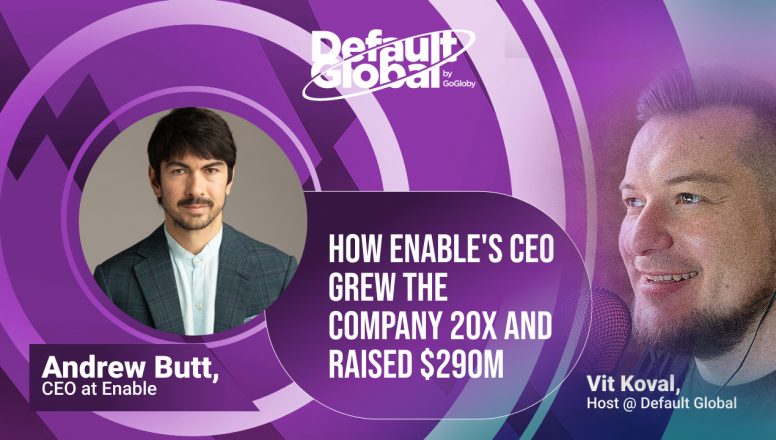Meet Jakob Knutzen, Co-Founder & CEO at Butter:
Jakob is an experienced entrepreneur and the CEO of Butter, a video conferencing tool designed specifically for workshops and trainings. His entrepreneurial journey began with a background in strategy consulting at Bain & Company in Denmark. Seeking new opportunities, he ventured to Indonesia and started a successful digital marketing agency. After selling the agency, Jakob returned to Denmark and co-founded a company focused on game streaming content discovery. Although the product didn’t succeed, he recognized the value of his exceptional co-founding team and decided to stick together.
In early 2020, Jakob and his team shifted their focus to the remote workspace, leveraging their experience in building a remote company. When the COVID-19 pandemic hit, they started conducting workshops to help teams transition to remote work. Through this experience, they identified the challenges of driving engaging remote workshops, leading them to create Butter—a tool that addresses the difficulties of managing technology, engagement, and interactivity during virtual workshops and trainings. With his passion for remote work and expertise in building scalable businesses, Jakob is committed to revolutionizing the way workshops and trainings are conducted online.
Listen Up: Jakob Knutzen, Co-Founder & CEO at Butter, Full Podcast Episode on Spotify
Watch Now: Global Hiring Challenges Faced by Startups: Insights from Butter CEO Jakob Knutzen
Quick Read: Jakob Knutzen, Co-Founder & CEO at Butter, Interview Highlights
How did your commitment to diverse and distributed teams influence their organization?
Jakob emphasized the numerous benefits of international hiring. He pointed out that one of the key advantages was the access to a wider talent pool that extends beyond the limitations of proximity. Jakob proudly shared that his company currently comprises 17 individuals from eight different countries, including Indonesia, Malaysia, Nigeria, Dubai, Portugal, and the Netherlands. The diversity in geographical origins has brought forth a range of exceptional talents.
Within the context of product development, Jakob highlighted another significant benefit. Having team members from diverse backgrounds contributes to building a more thoughtful and unbiased product. The varied perspectives enable the creation of a solution that caters to people from different cultures and accommodates their unique networking setups. For example, Jakob mentioned the contrasting networking and device environments in Indonesia compared to Denmark. By considering these differences, they strive to develop an inclusive product.
However, Jakob also acknowledged challenges associated with diverse backgrounds and cultures within the team. Despite the focus on hiring individuals with specific skills and a shared cultural mindset, the nuances of national cultures become apparent once they start working together. Overcoming these implicit biases and fostering a cohesive group dynamic requires time and effort.
Jakob’s Quote: “Having people from more diverse backgrounds just needs you to build a more thought-through product, a less biased product, if you will, because it’s a product that works for people from different cultures, but also from different networking setups.”
How do you address potential communication and collaboration challenges that may arise due to time zone differences, language barriers?
Jakob emphasized the significance of their screening process. During recruitment, they emphasize identifying individuals who align with the company’s set of operating principles. These principles encompass shared values that go beyond national cultures. They strive to create a cohesive team that transcends cultural boundaries by focusing on common mentalities and cultural mindsets. Jakob highlighted that the team members at Butter often have more in common with each other than Danish individuals do, for example, emphasizing the importance of finding shared values and cultural alignment.
While it is challenging to overcome cultural differences entirely, Jakob acknowledged that by fostering a common ground and alignment on important aspects, such as values and operating principles, they can mitigate potential obstacles and promote effective collaboration.
What obstacles did you face when hiring internationally, and how has Butter addressed these issues?
Jakob began by highlighting the initial challenge of knowing where to start when sourcing talent globally. With no geographical constraints, it becomes overwhelming to identify the right platforms and channels for recruitment. To overcome this obstacle, Butter implemented a strategic approach by narrowing down their focus to specific geographies. They carefully selected countries such as Indonesia, Malaysia, Nigeria, India, and certain parts of Europe, which provided ample talent pools for their needs.
Criteria for sourcing talent included strong English language skills, market familiarity, tech density, costs, and consideration of time zone differences. Jakob emphasized the importance of researching companies known for housing exceptional talent and using LinkedIn to target individuals with the desired job titles within those organizations.
Moving further down the hiring funnel, Jakob acknowledged the challenges of screening. Two primary areas of screening were skill assessment and cultural fit evaluation. Butter standardized skill tests, tailored to each specific product area, while observing variations in skill strengths across different geographies. For instance, they found strong product design talent in Northern Europe and robust engineering skills in Asia and Africa.
Assessing cultural fit posed an additional hurdle, particularly in screening for personality traits. Butter addressed this challenge by meticulously defining their operating principles and asking specific, deep-diving questions during interviews. By seeking examples and specific situations, they aimed to comprehensively understand candidates’ alignment with the company’s values and culture. However, Jakob acknowledged the ongoing difficulty of ensuring accurate screening on a personal level.
What distinguishing factors make Butter an attractive choice for potential hires from diverse parts of the world?
Jakob acknowledged the fierce competition with well-funded startups, unicorns, and large tech companies when it comes to recruiting top talent. He emphasized that the key differentiator for startups like Butter lies in attracting individuals who are excited about the challenges and autonomy inherent in a startup environment, rather than those solely driven by monetary benefits. Finding individuals who are motivated by the opportunity to contribute to something meaningful is crucial. This self-selection process often leads to attracting the best-suited candidates for the startup’s unique requirements.
Apart from the allure of challenges and autonomy, Butter also offers equity to all its employees, creating an additional incentive that excites potential hires. This equity-based approach aligns employees’ interests with the company’s long-term success, fostering a sense of ownership and motivation within the team.
Furthermore, Butter’s distinct culture, which is reflected in their operating principles and the content they share, plays a significant role in setting them apart as an employer of choice. Prospective hires are encouraged to assess whether they resonate with the team’s way of being and working, thus ensuring a strong cultural fit.
Butter follows a mixed approach when it comes to hiring teammates, depending on the geography and specific circumstances. Some individuals are engaged as full-time employees, while others are hired as contractors. For their Employer of Record needs, Butter utilizes the services of remote.com and Deel, leveraging the expertise and support provided by these platforms.
How Butter overcomes legal challenges and employment compliance issues associated with hiring remote workers? Whether you faced any legal issues or misclassification problems when working with teams in different countries?
Jakob explained that Butter conducted thorough research to ensure compliance with the employment laws of their countries. He mentioned that their focus lies in considering the full cost of the employee, rather than specific classifications. While some European countries with strict labor laws posed challenges for Butter, they have been cautious in their approach to mitigate any negative impacts. Jakob emphasized that they treat all their team members as part of the core team, irrespective of the specific contractual arrangement. Moreover, Butter provides employees with choices regarding their classification within the legal framework, allowing flexibility that aligns with the preferences of the individuals.
What’s your perspective on whether outsourcing could still be a viable option for long-term collaboration, considering Butter’s past experience?
Jakob expressed his strong opinions on outsourcing, highlighting the need for caution when it comes to outsourcing core business functions, especially in the early stages of a startup. He emphasized that startups must have in-house capabilities to build their core products and manage them effectively. However, Jakob acknowledged that outsourcing can be helpful for temporary projects or non-core business areas, as well as for specialized tasks where full-time employees may not be necessary. He mentioned that outsourcing could still be an option, but it requires careful consideration and is more suitable for later-stage startups. Jakob agreed that the outsourcing industry is undergoing transformation, and while it may still have a place in the future, the way outsourcing is managed and utilized is likely to change.
How leading a global team shapes your leadership style and approach to team management?
Jakob shared his insights on managing global teams, highlighting the importance of being conscious and explicit in all aspects of team management. He emphasized the need for well-documented processes, clear communication channels, and explicit operating principles or values. Jakob explained that unlike co-located teams where culture can naturally form, remote teams require deliberate efforts to establish and communicate the team’s culture. He emphasized that this conscious and explicit approach, though initially requiring more effort, ultimately leads to scalability as the team grows. Jakob concluded that managing a global team requires meticulous attention to detail and a focus on clear and transparent communication.
Can you share three key pieces of advice for those entrepreneurs and executives who are early to this?
When asked about advice for those new to global hiring and remote work, Jakob emphasized the importance of choosing between co-located and remote teams, cautioning against the hybrid approach. He expressed that hybrid setups often lead to complications and muddy decision-making. Jakob stated, “If you do hybrid, everything gets more muddy up. Everything gets less.” He further explained that being explicit and documenting decisions becomes challenging when navigating the hybrid model. With co-located teams, it is easier to gather necessary individuals for discussions and key decision-making moments. Remote teams, on the other hand, provide the advantage of seamless collaboration and unhindered access to talent from around the world.
In addition to choosing between co-located and remote teams, Jakob highlighted the need to be aware of the costs and benefits associated with remote work. He emphasized that remote setups offer tremendous advantages in terms of accessing top talent and scalability. However, he cautioned that remote work also requires a higher level of explicitness and investment in the early stages. Entrepreneurs and executives should make a deliberate choice between remote and co-located work environments, fully considering the pros and cons, and then commit to their decision.
The third key piece of advice offered by Jakob revolved around communication strategies. He stressed the importance of finding a balance between synchronous and asynchronous communication. Jakob stated, “Be very conscious about your communication, what you do, synchronous and asynchronous.” He warned against defaulting to fully asynchronous communication, which may hinder team collaboration and result in isolation. On the other hand, relying solely on synchronous communication can lead to excessive and inefficient meetings. Finding the right synchronous and asynchronous communication distribution is a powerful decision that can optimize workflow efficiency and foster effective collaboration.
As the demand for remote work continues to grow, entrepreneurs and executives embarking on building a distributed workforce can benefit from these valuable insights. Organizations can navigate the challenges and leverage the advantages of remote work by making a clear choice between co-located and remote teams, carefully weighing the costs and benefits, and implementing a well-balanced communication strategy.






